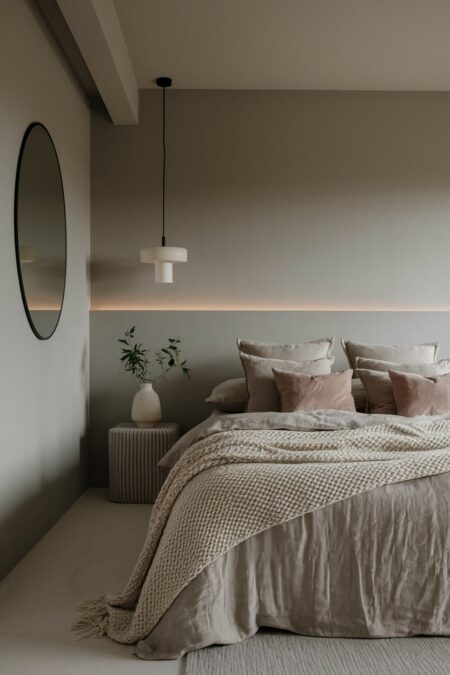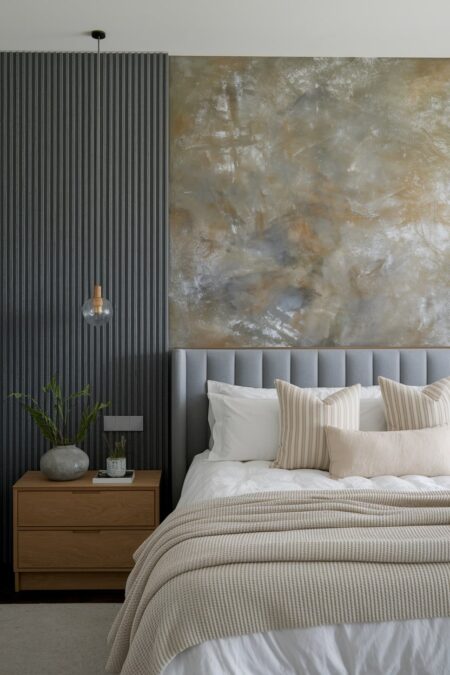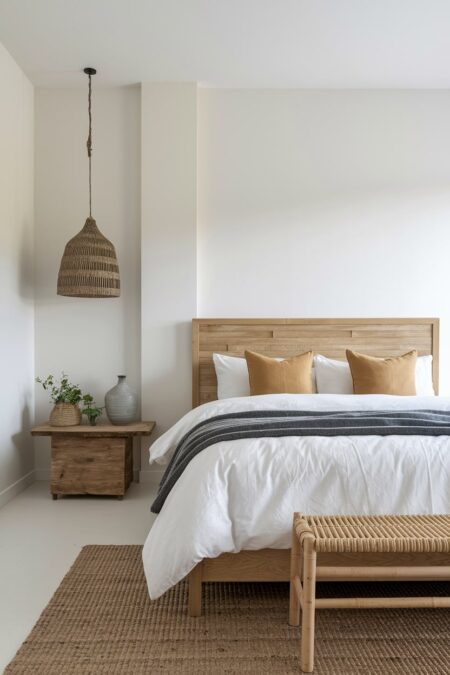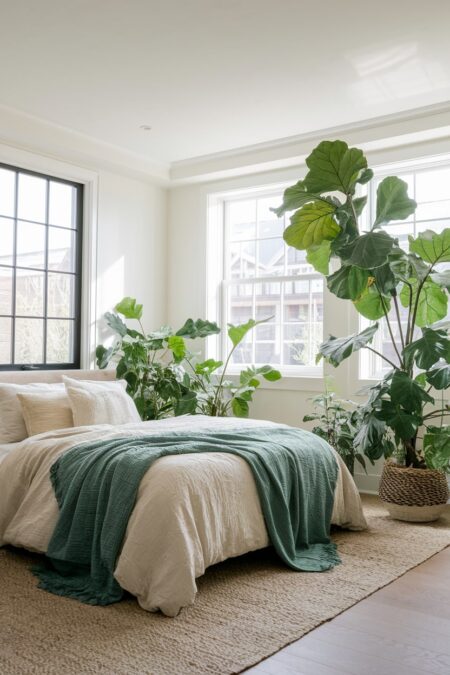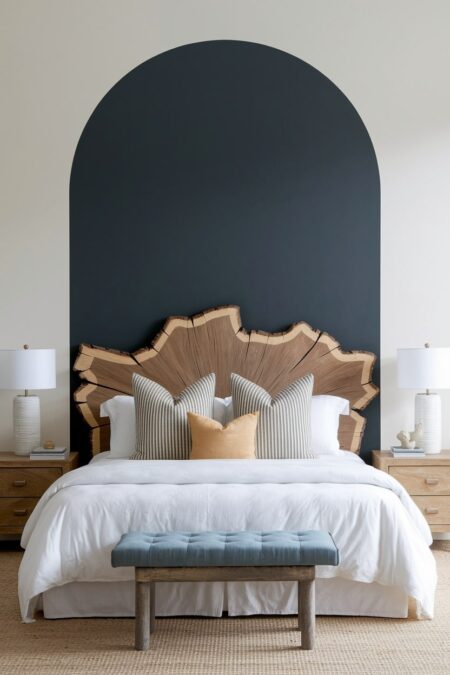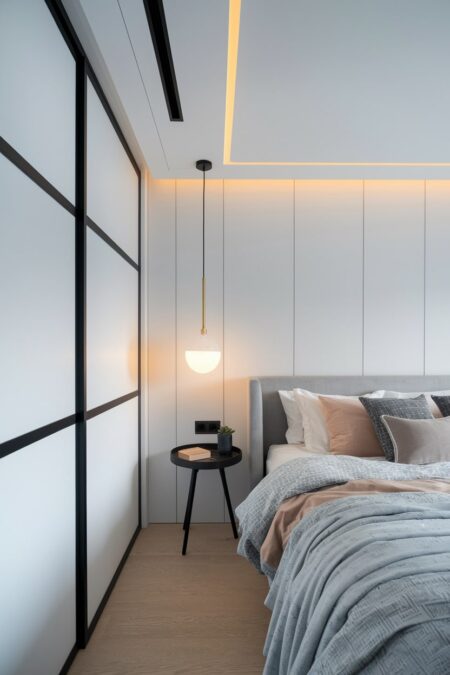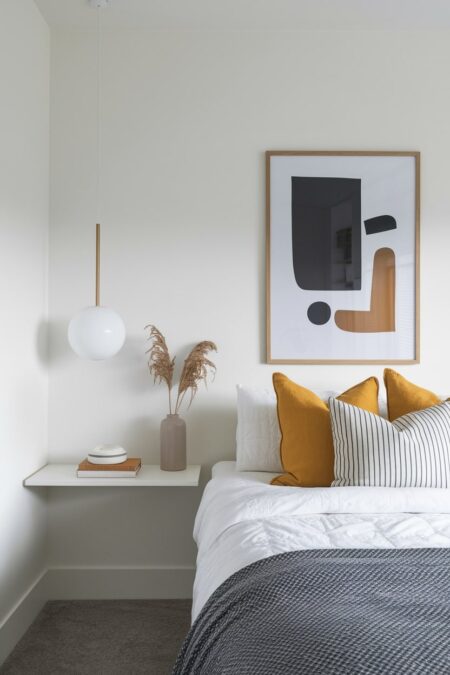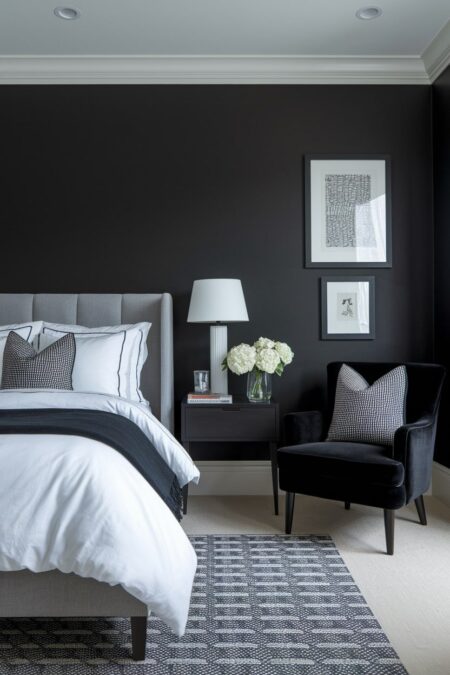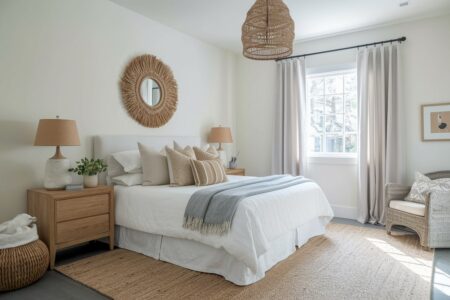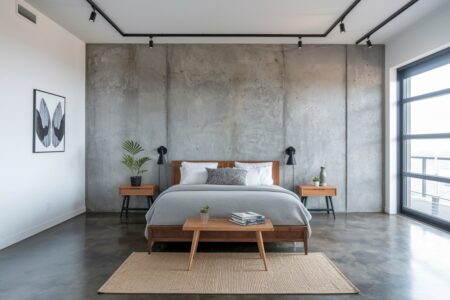The modern bedroom is more than just a place to sleep; it is a sanctuary designed for rest, relaxation, and personal expression. Moving away from ornate and cluttered styles, contemporary design emphasizes clean lines, uncluttered spaces, and a thoughtful curation of furniture and decor. The goal is to create an environment that feels both sophisticated and deeply calming. Achieving this aesthetic involves a careful balance of color, texture, and light to craft a space that is both functional and beautifully serene.
Whether you are starting from a blank canvas or looking to infuse a modern sensibility into your existing space, these ideas will guide you in transforming your bedroom into a stylish and tranquil retreat.
If you are seeking a particular interior design style, look into articles about mid-century modern bedroom design and contemporary bedroom ideas. They can offer you some great inspiration!
-
01 of 15
The Monochromatic Foundation
A monochromatic color scheme provides a powerful foundation for a modern bedroom. By using various tones, shades (like taupe), and tints of a single color, such as gray, beige, or even a soft white, you can create a cohesive and calming atmosphere. This approach allows the mind to rest, free from the distraction of competing colors, enhancing the room’s sense of tranquility and spaciousness.
To prevent a single-color palette from feeling flat, focus on introducing a rich variety of textures. Combine a soft, chunky knit throw with smooth linen bedding, and add velvet or bouclé accent pillows. This layering of materials adds visual weight and sensory depth, making the space feel sophisticated and inviting without sacrificing its minimalist principles.
-
02 of 15
Statement Lighting as Art
In modern design, lighting transcends mere function to become a central artistic feature. Replace standard ceiling fixtures with a bold, sculptural pendant light or a minimalist chandelier that acts as a focal point. Wall-mounted sconces with unique geometric shapes or articulated arms can flank the bed, freeing up space on your nightstands while adding a touch of architectural interest.
Consider the scale of your room when selecting your statement piece. In a room with high ceilings, a larger fixture can create a dramatic effect. For a more intimate feel, hang a pendant light lower than usual over a nightstand or in a reading corner. This not only provides focused light but also draws the eye and defines a specific zone within the room.
-
03 of 15
The Power of Textural Walls
Move beyond flat, painted walls by introducing texture to create depth and character. A single accent wall behind the bed can transform the entire room. Materials like fluted wood paneling add linear interest and warmth, while a limewash or Venetian plaster finish provides a soft, organic texture with subtle variations in color.
This technique allows you to add a significant design element without introducing clutter. A textured wall serves as a built-in piece of art, providing a sophisticated backdrop for your bed and headboard. Choose a texture that complements the overall mood you wish to create, from the rustic appeal of limewash to the refined elegance of upholstered panels.
-
04 of 15
Floating Furniture for an Airy Feel
To enhance the sense of openness that is central to modern design, consider furniture that appears to float. Wall-mounted nightstands and vanities, along with floating bed frames, lift storage and surfaces off the ground. This simple change creates unbroken floor space, which makes the room feel larger, cleaner, and more breathable.
When installing floating furniture, ensure your walls are capable of supporting the weight. The open space beneath can be left clear to maximize the airy aesthetic or used for low-profile, minimalist storage baskets that keep clutter out of sight. This design choice is particularly effective in small bedrooms where maximizing the perception of space is key.
-
05 of 15
Japandi: A Fusion of Styles
Japandi design is a harmonious blend of Japanese rustic minimalism and Scandinavian functionality. This hybrid style focuses on clean lines, natural materials, and a deep appreciation for craftsmanship and simplicity. The result is a space that is warm, uncluttered, and effortlessly calming, combining the best of both design philosophies.
To cultivate a Japandi aesthetic, prioritize furniture made from light-toned woods like oak or ash. Incorporate natural elements such as bamboo, rattan, and stone. Keep the color palette neutral and muted, and focus on acquiring a few high-quality, well-made pieces rather than an abundance of decor. The ultimate goal is to create a space that feels both mindful and functional.
RELATED: 12 Japandi Bedroom Ideas for a Tranquil, Mindful Space
-
06 of 15
Biophilic Design for Wellness
Biophilic design is the practice of connecting our indoor spaces with the natural world. This concept goes beyond simply adding a few houseplants; it involves a holistic approach to incorporating nature into your bedroom to improve well-being. Think large windows that maximize natural light, the use of organic materials, and, of course, plenty of greenery.
Introduce large-scale plants like a Fiddle Leaf Fig or a Monstera to make a bold statement. Choose bedding and textiles made from natural fibers such as linen, cotton, or wool. By thoughtfully integrating these natural elements, you can create a bedroom that not only looks beautiful but also fosters a deeper sense of connection and calm.
-
07 of 15
The Unconventional Headboard
Rethink the traditional headboard by transforming it into a unique design statement. Instead of a standard frame, consider a floor-to-ceiling upholstered panel in a rich fabric or a large slab of live-edge wood for a more organic touch. For a minimalist yet impactful solution, you can paint a large arch or a geometric shape on the wall behind the bed to frame it.
The key is to view the area behind your bed as an opportunity for creativity. This approach allows you to anchor the room’s most important piece of furniture with a feature that reflects your personal style. Ensure the scale of your chosen headboard alternative is proportionate to your bed and the overall size of the room to maintain a sense of balance.
-
08 of 15
Seamless Smart Technology Integration
Modern living is increasingly integrated with technology, and the bedroom is no exception. Smart technology can enhance comfort and convenience without disrupting the minimalist aesthetic. Concealed speakers, automated blinds that open with the sunrise, and smart lighting systems allow you to control the room’s ambiance with a simple voice command or tap of an app.
A great starting point is to replace traditional light bulbs with smart bulbs. This enables you to adjust both the brightness and color temperature of your lighting, creating a bright, energizing environment in the morning and a warm, relaxing glow in the evening. The goal is to make technology work for you in a way that feels intuitive and invisible.
-
09 of 15
Layering Rugs for Coziness
While hardwood or polished concrete floors are a staple of modern interiors, they can sometimes feel cold. Soften the space and add visual interest by layering rugs. This technique adds warmth, texture, and a touch of curated style. A common approach is to place a smaller, high-pile rug over a larger, low-pile natural fiber rug like jute or sisal.
When layering, choose rugs with complementary colors or subtle patterns to avoid a chaotic look. The top rug should be significantly smaller so that the bottom one acts as a frame. This intentional layering adds a cozy, lived-in dimension to the clean lines of a modern bedroom, making it feel more inviting.
-
10 of 15
Minimalist Window Treatments
Heavy, ornate curtains have no place in a modern bedroom. Instead, opt for clean and simple window treatments that provide privacy and light control without adding visual bulk. Sleek roller shades that disappear when raised, light-filtering cellular shades, or simple linen curtain panels are all excellent choices.
To achieve a seamless look, select window treatments in a color that closely matches your wall color. This helps them blend in, maintaining the room’s uncluttered and cohesive feel. The focus should be on function and simplicity, allowing the architecture of the window and the natural light to take center stage.
-
11 of 15
Curated Art and Decor
The modern approach to decor is “less is more.” Instead of filling every surface with trinkets, select a few meaningful items that make a significant impact. A single, large-scale piece of abstract art hung above the bed can serve as the room’s main focal point. Alternatively, a small, curated gallery of personal photos in identical, simple frames can add a personal touch without creating clutter.
Each decorative object should have a purpose and a place. Give your chosen items room to breathe, allowing their form and beauty to be fully appreciated. This intentional approach to decoration is what separates a sterile room from a serene and thoughtfully designed modern space.
-
12 of 15
Sustainable and Organic Materials
A growing trend in modern design is a focus on sustainability and health. This translates to choosing furniture and decor made from eco-friendly and non-toxic materials. Look for bedroom furniture crafted from reclaimed wood or sustainably harvested bamboo. Select bedding made from organic cotton or linen, which is better for both the environment and your well-being.
Incorporating sustainable materials does not require a complete overhaul. You can start small by choosing a low-VOC (volatile organic compound) paint for your walls or investing in a high-quality set of organic bedding. These choices contribute to a healthier indoor environment and add a layer of mindful intention to your design.
-
13 of 15
The Elegance of Low-Profile Platforms
Low-profile platform beds are a hallmark of modern bedroom design. These low-slung frames create a grounded, Zen-like feeling that promotes relaxation. By sitting closer to the floor, they make the ceiling appear higher, enhancing the room’s sense of vertical space and openness.
This minimalist bed style pairs best with equally low-profile nightstands to maintain a consistent horizontal line. The simplicity of a platform bed provides a perfect, unobtrusive base for showcasing beautiful bedding and accent pillows, reinforcing the clean and uncluttered aesthetic of the room.
-
14 of 15
Hidden and Integrated Storage
Clutter is the primary adversary of modern design. To maintain a serene and organized space, storage solutions should be as invisible as possible. Consider floor-to-ceiling built-in wardrobes that are painted the same color as the walls, allowing them to blend in seamlessly. Beds with hydraulic lift mechanisms reveal ample storage space underneath, perfect for stowing away seasonal items.
When choosing freestanding furniture like dressers or chests, opt for pieces with flat-front designs and minimal or no hardware. Push-to-open mechanisms are an excellent choice for maintaining a sleek, uninterrupted surface. The goal is to have a place for everything, keeping visible surfaces clear and the mind at ease.
-
15 of 15
A Touch of Bold Contrast
While neutral palettes are common in modern bedrooms, a strategic touch of bold contrast can add drama and personality without compromising the style. An accent wall painted in a deep, moody color like charcoal, navy blue, or forest green can create a stunning and intimate atmosphere. This dark backdrop makes lighter furniture and artwork pop.
If a full accent wall feels too committal, introduce contrast through textiles. A dark-colored duvet cover, a black velvet armchair, or dark-framed art can provide the same sense of depth and sophistication on a smaller scale. This deliberate use of contrast adds a layer of visual interest that keeps the design feeling dynamic and personalized.

